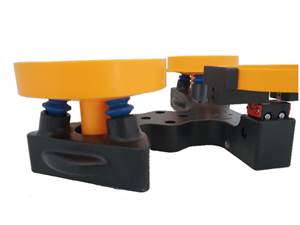No. 22 - Takeout Robots
Automated part takeout was said to originate in Japan in 1967 with Sailor Pen Co., one of the first manufacturers in the region to use injection molding presses.
Automated part takeout was said to originate in Japan in 1967 with Sailor Pen Co., one of the first manufacturers in the region to use injection molding presses. The company, which began molding parts for its fountain pens and ink cartridges in 1949, developed an automatic extraction robot to improve parts handling. In 1969, it introduced the RX-0 extraction robot for sale. This pneumatic swing-type model (similar to a sprue picker) gained wide popularity in Japan due to post-war labor shortages. From 1969 to ’71, Harmo, Star, and Yushin also started making robots.
Pressures on labor cost and availability in the U.S., as well as trends toward larger and more complex injection molded parts that required special handling in stead of simply falling out of the mold, drove U.S. molders to try automated parts handling in the early 1970s. The first units were pneumatically driven, top-mounted systems with relay controls and limited flexibility.
Takeout robots attracted attention at NPE 1973, where models with up to five axes were exhibited by Reed-Prentice and Toyomenka. In 1976, robots first appeared in Plastics Technology’s annual Manufacturing Handbook & Buyers’ Guide, which listed only Martin Industries (later Conair Martin) in Chicopee, Mass., as having a truly plastics-oriented robot.
From the mid-’70s to early ’80s, manufacturing quality and productivity issues drove the adoption of takeout robots in the U.S. Robots allowed a consistent molding cycle, eliminating operator variability. The occupational safety regulations of the 1970s added an incentive to keep operators out of the press. (Traversing takeout robots also started appearing on large industrial blow molders by the mid-1970s.)
From Japan, the first standard traversing-type robots were introduced around 1975, which allowed for a greater range of automated operations. Around 1977, Automated Assemblies, a venture of custom molder Nypro, began selling robots. Nypro claims that starting in 1981 it was the first U.S. plastics firm to put a robot on every press.
In Europe, robots were introduced by Witt mann in 1976 and Remak in 1978. At the K ’79 show in Dusseldorf, robots accompanied many injection mold ing exhibits. Around 1980, Con air brought out its first robot, the Automate, a cam-operated, side-entry unit. Husky became the first injection press builder in North America to offer its own robots. Battenfeld, Bucher, Engel, and others soon followed.
In 1981, Nelmor Div. of AEC and the new Sterltech Div. of Sterling Inc. began marketing robots for insert loading and parts removal. Also in 1981, Thermwood Corp. introduced a moderately priced jointed-arm robot with simplified “lead-through” programming. Robots “stole the show” at both Interplas ’81 in Birmingham, England, and NPE 1982, with a great variety of traversing and jointed-arm models.
In 1983 came speedier pneumatic cylinders, as well as electric servo drive systems that promised even higher speed and precision. Servos also allowed position setpoints to be set electronically instead of setting mechanical stops.
The year 1985 saw the arrival of telescoping arms that accommodated low ceilings. At the same time, companies such as Yushin introduced “hybrid” air and electric drive systems. Robot programmability and functionality progressed in the mid-1980s with the introduction of programmable logic controllers, which allowed for easier sequence programming, quick program changes, and easier incorporation of secondary operations such as stacking, packing, decorating, and assembly. All-servo robots came onto the market from Japan at the end of the 1980s. Today, around 95% of takeout robots are all or partly servo driven.
An estimated 80% of the injection molding firms and 40% of the presses in the U.S. have takeout robots. In Japan, 100% of molding shops and 80% of the presses use robots. Europe is said to be somewhere in between.
Related Content
Boston Dynamics Stretches Into Autonomous Warehouse Robotics
The robotics company’s second commercial product is designed to take on physically challenging warehouse tasks.
Read MoreBMW Group Vehicle to Adopt 3D Printed Center Console
A vehicle coming to market in 2027 will include a center console carrier manufactured through polymer robot-based large-format additive manufacturing (LFAM).
Read MorePaperless ‘Smart Factory’ Based on Automated Production Monitoring
Tier 1 automotive molder’s home-built production-monitoring and ERP systems, designed for “the little guy,” boost its efficiency rating and profits.
Read MoreEnsuring Repeatability: The Key to Effective Injection Molding Automation
One of automation’s key promises is repeatability: the same movement to the same location, time and time again. But to achieve that, all elements involved — robot, machine, EOAT, mold — must be in and stay in alignment.
Read MoreRead Next
Beyond Prototypes: 8 Ways the Plastics Industry Is Using 3D Printing
Plastics processors are finding applications for 3D printing around the plant and across the supply chain. Here are 8 examples to look for at NPE2024.
Read MoreFor PLASTICS' CEO Seaholm, NPE to Shine Light on Sustainability Successes
With advocacy, communication and sustainability as three main pillars, Seaholm leads a trade association to NPE that ‘is more active today than we have ever been.’
Read More











